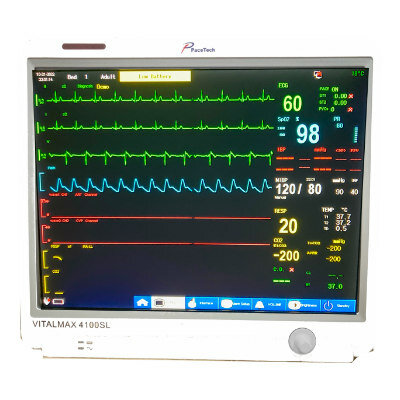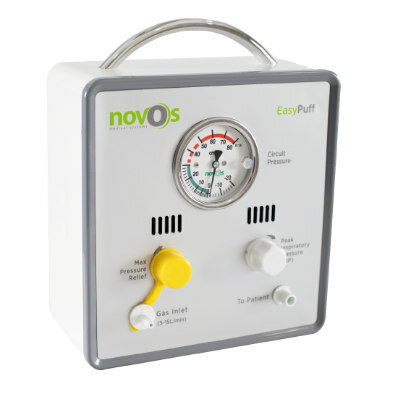AI Algorithm Identifies Hospitalized Patients at Highest Risk of Dying From COVID-19
|
By HospiMedica International staff writers Posted on 18 May 2022 |

Scientists have developed and validated an algorithm that can help healthcare professionals identify who is most at risk of dying from COVID-19 when admitted to a hospital. The tool, which uses artificial intelligence (AI), could help doctors direct critical care resources to those who need them most, and will be especially valuable to resource-limited countries.
To develop the tool, an international team led by the University of Vienna (Vienna, Austria) used biochemical data from routine blood draws performed on nearly 30,000 patients hospitalised in over 150 hospitals in Spain, the US, Honduras, Bolivia and Argentina between March 2020 and February 2022. This means they were able to capture data from people with different immune statuses - vaccinated, unvaccinated and those with natural immunity - and from people infected with every SARS-CoV-2 variant, from the virus that emerged in Wuhan, China, to the latest Omicron variant.
The resulting algorithm - called COVID-19 Disease Outcome Predictor (CODOP) - uses measurements of 12 blood molecules that are normally collected during admission. This means the predictive tool can be easily integrated into the clinical care of any hospital. CODOP was developed in a multistep process, initially using data from patients hospitalized in more than 120 hospitals in Spain, to ‘train’ the AI system to predict hallmarks of a poor prognosis. The next step was to ensure the tool worked regardless of patients’ immune status or COVID-19 variant, so they tested the algorithm in several subgroups of geographically dispersed patients. The tool still performed well at predicting the risk of in-hospital death during this fluctuating scenario of the pandemic, suggesting the measurements CODOP is based on are truly meaningful biomarkers of whether a patient with COVID-19 is likely to deteriorate.
To test whether the time of taking blood tests affects the tool’s performance, the team compared data from different time points of blood drawn before patients either recovered or died. They found that the algorithm can predict the survival or death of hospitalized patients with high accuracy until nine days before either outcome occurs. Finally, they created two different versions of the tool for use in scenarios where healthcare resources are either operating normally or are under severe pressure. Under normal operational burden, doctors may opt to use an ‘overtriage’ version, which is highly sensitive at picking up people at increased risk of death, at the expense of detecting some people who did not require critical care. The alternative ‘undertriage’ model minimizes the possibility of wrongly selecting people at lower risk of dying, providing doctors with greater certainty that they are directing care to those at the highest risk when resources are severely limited.
“The performance of CODOP in diverse and geographically dispersed patient groups and the ease of use suggest it could be a valuable tool in the clinic, especially in resource-limited countries,” said the leader of this international project and senior author David Gómez-Varela, former Max Planck Group Leader and current Senior Scientist at the Division of Pharmacology and Toxicology, University of Vienna. “We are now working on a follow-up dual model tailored to the current pandemic scenario of increasing infections and cumulative immune protection, which will predict the need for hospitalization within 24 hours for patients within primary care, and intensive care admission within 48 hours for those already hospitalized. We hope to help healthcare systems restore previous standards of routine care before the pandemic took hold.”
Related Links:
University of Vienna
Latest COVID-19 News
- Low-Cost System Detects SARS-CoV-2 Virus in Hospital Air Using High-Tech Bubbles
- World's First Inhalable COVID-19 Vaccine Approved in China
- COVID-19 Vaccine Patch Fights SARS-CoV-2 Variants Better than Needles
- Blood Viscosity Testing Can Predict Risk of Death in Hospitalized COVID-19 Patients
- ‘Covid Computer’ Uses AI to Detect COVID-19 from Chest CT Scans
- MRI Lung-Imaging Technique Shows Cause of Long-COVID Symptoms
- Chest CT Scans of COVID-19 Patients Could Help Distinguish Between SARS-CoV-2 Variants
- Specialized MRI Detects Lung Abnormalities in Non-Hospitalized Long COVID Patients
- Sweat Sensor Detects Key Biomarkers That Provide Early Warning of COVID-19 and Flu
- Study Assesses Impact of COVID-19 on Ventilation/Perfusion Scintigraphy
- CT Imaging Study Finds Vaccination Reduces Risk of COVID-19 Associated Pulmonary Embolism
- Third Day in Hospital a ‘Tipping Point’ in Severity of COVID-19 Pneumonia
- Longer Interval Between COVID-19 Vaccines Generates Up to Nine Times as Many Antibodies
- AI Model for Monitoring COVID-19 Predicts Mortality Within First 30 Days of Admission
- AI Predicts COVID Prognosis at Near-Expert Level Based Off CT Scans
- ECG Can Pinpoint Hospitalized COVID-19 Patients at High Risk of Death
Channels
Artificial Intelligence
view channel
AI-Powered Algorithm to Revolutionize Detection of Atrial Fibrillation
Atrial fibrillation (AFib), a condition characterized by an irregular and often rapid heart rate, is linked to increased risks of stroke and heart failure. This is because the irregular heartbeat in AFib... Read more
AI Diagnostic Tool Accurately Detects Valvular Disorders Often Missed by Doctors
Doctors generally use stethoscopes to listen for the characteristic lub-dub sounds made by heart valves opening and closing. They also listen for less prominent sounds that indicate problems with these valves.... Read moreCritical Care
view channel
Deep-Learning Model Predicts Arrhythmia 30 Minutes before Onset
Atrial fibrillation, the most common type of cardiac arrhythmia worldwide, affected approximately 59 million people in 2019. Characterized by an irregular and often rapid heart rate, atrial fibrillation... Read more
Breakthrough Technology Combines Detection and Treatment of Nerve-Related Disorders in Single Procedure
The peripheral nervous system (PNS) serves as the communication network that links the brain and spinal cord to every other part of the body. It consists of two parts: the somatic nervous system, which... Read moreSurgical Techniques
view channel
Hydrogel-Based Miniaturized Electric Generators to Power Biomedical Devices
The development of engineered devices that can harvest and convert the mechanical motion of the human body into electricity is essential for powering bioelectronic devices. This mechanoelectrical energy... Read moreWearable Technology Monitors and Analyzes Surgeons' Posture during Long Surgical Procedures
The physical strain associated with the static postures maintained by neurosurgeons during long operations can lead to fatigue and musculoskeletal problems. An objective assessment of surgical ergonomics... Read more.jpg)
Custom 3D-Printed Orthopedic Implants Transform Joint Replacement Surgery
The evolving field of 3D printing is revolutionizing orthopedics, especially for individuals requiring joint replacement surgeries where traditional implants fail to provide a solution. Although most people... Read more
Cutting-Edge Imaging Platform Detects Residual Breast Cancer Missed During Lumpectomy Surgery
Breast cancer is becoming increasingly common, with statistics indicating that 1 in 8 women will develop the disease in their lifetime. Lumpectomy remains the predominant surgical intervention for treating... Read morePatient Care
view channel
Surgical Capacity Optimization Solution Helps Hospitals Boost OR Utilization
An innovative solution has the capability to transform surgical capacity utilization by targeting the root cause of surgical block time inefficiencies. Fujitsu Limited’s (Tokyo, Japan) Surgical Capacity... Read more
Game-Changing Innovation in Surgical Instrument Sterilization Significantly Improves OR Throughput
A groundbreaking innovation enables hospitals to significantly improve instrument processing time and throughput in operating rooms (ORs) and sterile processing departments. Turbett Surgical, Inc.... Read more
Next Gen ICU Bed to Help Address Complex Critical Care Needs
As the critical care environment becomes increasingly demanding and complex due to evolving hospital needs, there is a pressing requirement for innovations that can facilitate patient recovery.... Read moreGroundbreaking AI-Powered UV-C Disinfection Technology Redefines Infection Control Landscape
Healthcare-associated infection (HCAI) is a widespread complication in healthcare management, posing a significant health risk due to its potential to increase patient morbidity and mortality, prolong... Read moreHealth IT
view channel
Machine Learning Model Improves Mortality Risk Prediction for Cardiac Surgery Patients
Machine learning algorithms have been deployed to create predictive models in various medical fields, with some demonstrating improved outcomes compared to their standard-of-care counterparts.... Read more
Strategic Collaboration to Develop and Integrate Generative AI into Healthcare
Top industry experts have underscored the immediate requirement for healthcare systems and hospitals to respond to severe cost and margin pressures. Close to half of U.S. hospitals ended 2022 in the red... Read more
AI-Enabled Operating Rooms Solution Helps Hospitals Maximize Utilization and Unlock Capacity
For healthcare organizations, optimizing operating room (OR) utilization during prime time hours is a complex challenge. Surgeons and clinics face difficulties in finding available slots for booking cases,... Read more
AI Predicts Pancreatic Cancer Three Years before Diagnosis from Patients’ Medical Records
Screening for common cancers like breast, cervix, and prostate cancer relies on relatively simple and highly effective techniques, such as mammograms, Pap smears, and blood tests. These methods have revolutionized... Read morePoint of Care
view channel
Critical Bleeding Management System to Help Hospitals Further Standardize Viscoelastic Testing
Surgical procedures are often accompanied by significant blood loss and the subsequent high likelihood of the need for allogeneic blood transfusions. These transfusions, while critical, are linked to various... Read more
Point of Care HIV Test Enables Early Infection Diagnosis for Infants
Early diagnosis and initiation of treatment are crucial for the survival of infants infected with HIV (human immunodeficiency virus). Without treatment, approximately 50% of infants who acquire HIV during... Read more
Whole Blood Rapid Test Aids Assessment of Concussion at Patient's Bedside
In the United States annually, approximately five million individuals seek emergency department care for traumatic brain injuries (TBIs), yet over half of those suspecting a concussion may never get it checked.... Read more
New Generation Glucose Hospital Meter System Ensures Accurate, Interference-Free and Safe Use
A new generation glucose hospital meter system now comes with several features that make hospital glucose testing easier and more secure while continuing to offer accuracy, freedom from interference, and... Read moreBusiness
view channel
Johnson & Johnson Acquires Cardiovascular Medical Device Company Shockwave Medical
Johnson & Johnson (New Brunswick, N.J., USA) and Shockwave Medical (Santa Clara, CA, USA) have entered into a definitive agreement under which Johnson & Johnson will acquire all of Shockwave’s... Read more

















